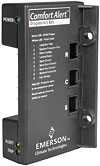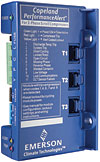
Comfort Alert™ diagnostics has proven to significantly improve diagnostic accuracy for both entry-level and trained technicians.
Similar electronics and diagnostics have been used by furnace manufacturers for years, so it was a natural extension for air conditioning and refrigeration. A recent Emerson market research study conducted by a third party (Thinking Cap) also concluded that HVACR end-users and contractors are looking for predictive intelligence and lifetime fault history retrieval. Fortunately for the industry, compressor electronics provide a solution for these important needs.
Now armed with this innovative technology, air conditioning and refrigeration contractors are successfully up-selling systems with compressor electronics to customers who want improved reliability and lower lifetime costs. The number of air conditioning systems with embedded compressor electronics have increased tenfold over the last five years, and refrigeration expects that 13 percent of supermarkets built in 2009 will utilize compressor electronics. This is proof that, while this beneficial technology is relatively new, it is here to stay.
THE INS AND OUTS OF COMPRESSOR ELECTRONICS
If there was ever a question about the need for compressor electronics, look no further than the high rate of warranty returns that are classified by the manufacturer as No Fault Found (NFF). Approximately one-third of all air conditioning and refrigeration compressors returned under warranty are NFF. This creates major inefficiencies and adds unnecessary cost throughout the channel, from contractor to wholesaler to manufacturer. The ability to improve diagnostic accuracy not only aids the contractor with faster, more accurate diagnosis, it also helps to reduce cost throughout the entire channel by significantly reducing the number of compressors returned with NFF.So how do compressor electronics actually work? The basic premise involves using the compressor as a sensor to monitor the system and diagnose performance. Devices are installed in the outdoor unit to track operating data from the compressor and then interpreted using advanced compressor and system knowledge.
At Emerson Climate Technologies, for example, the compressor electronics platform utilizes current sensing of Copeland® compressors to interpret system and electrical information that can deliver diagnostics, and in the future, other advanced capabilities. As an example, the device can determine whether the system charge is too high or low for reliable operation, without adding costly pressure and temperature sensors. Fault codes provide information to help the service technician more quickly and accurately identify the root cause of system problems.

Comfort Alert™ diagnostics (left) and Copeland PerformanceAlert™ refrigeration diagnostics (right).
MEETING CUSTOMER NEEDS
Compressor electronics have been designed for air conditioning, heat pump, and refrigeration systems. However, there are some differences in the capabilities depending on whether the application is residential or commercial. For example, features on commercial devices may vary by type of equipment and are generally more advanced due to the sophisticated nature and high cost of these systems.Residential Compressor Electronics- Found inside the electrical box of the outdoor condensing unit, residential compressor electronics offer many benefits to contractors and technicians. Without compressor electronics, service technicians have to rely on years of technical experience, critical system measurements, good judgment, and after-the-fact analysis when troubleshooting a unit. The technician may be able to run the system and duplicate the problem, but might never know with certainty what caused the issue. He might even replace the compressor or other components, when in fact the root cause of the problem is elsewhere in the system.
Compressor electronics allow a contractor to monitor the system on an ongoing basis. Much like a check engine light in a car, compressor electronics provide real-time alerts, sending a “call for service” message to the home- owner via the thermostat.
These alerts not only generate leads for service calls, but also will, more importantly, prevent greater damage to the compressor or system before a loss occurs. By guiding technicians to diagnose the problem, compressor electronics enable a quicker, more accurate solution the first time. In the end, it gives homeowners enhanced confidence in the reliability of their air conditioning system.
Commercial Compressor Electronics- Compressor electronics for commercial applications are found today in air conditioning rooftops, indoor and outdoor condensing units for refrigerated coolers and freezers, ice machines, large supermarket refrigeration systems, and other discrete commercial equipment.
Providing similar benefits as residential compressor electronics, the commercial electronic devices located on the system are networked together, so service managers can access the system remotely to see how it is performing and troubleshoot if necessary. Because the service manager knows about system faults before arriving at the site, he will be better prepared to handle the problem and avoid an unnecessary second trip. He also benefits from simplifying the steps to diagnose, which makes his job easier and gives him assurance that systems are performing as designed.
End-users benefit from the peace-of-mind of knowing their HVAC systems and equipment are operating at peak performance. With compressor electronics installed at their sites, they experience improved reliability and lower maintenance costs. The resulting improvements in system uptime can translate to significant operational savings. For example, if the system shuts down or fails, a refrigeration end-user risks losing perishable product, which translates into lost profits.

Comfort Alert™ diagnostics (left) and Copeland PerformanceAlert™ refrigeration diagnostics (right).
ENHANCING NEW EQUIPMENT
The majority of compressor electronics in the field today were installed with new equipment that offer unique benefits to OEMs, giving them an opportunity to significantly reduce warranty costs, differentiate their product with advanced compressor diagnostics and protection, and provide potential cost savings for their customers. Perhaps most importantly, equipment with embedded diagnostics will help reduce callbacks and improve contractors’ profitability and reputation in their market.RETROFIT OR SERVICE OPPORTUNITIES
While compressor electronics offer benefits when installed in new equipment, they can also be retrofitted into existing equipment. By adding compressor electronics to existing equipment, end users and contractors are able to increase the reliability of the system, simplify maintenance and troubleshooting, and enable the capability to monitor the equipment remotely. Technologies like compressor electronics are perfect companions for service agreements, benefiting the homeowner, end-user, and contractor alike.NEW OPPORTUNITIES
Although an advanced technology already, compressor electronics offer even more opportunities for this year’s installations, including advanced diagnostics for accurate troubleshooting and system failure and callback reduction. In addition, the technology is now embedded on communicating systems, which can further benefit the contractor by simplifying system installation using auto-configure features.Compressor electronics provide unique solutions to improve reliability and performance of compressors and systems for OEMs, contractors, and end-users. Since the compressor is the heart of the system, we predict that this new category of compressor electronics will continue to develop and grow rapidly in the next few years as performance demands increase. Contractors can stay ahead of the curve with their business by learning more about these new electronics, up-selling them to homeowners and end-users, and preparing service technicians to install and work with them in the field.
Sidebar: Electronic Solutions
Emerson Climate Technologies offers compressor electronics solutions for both the refrigeration and air conditioning markets. Comfort Alert® diagnostics for residential and commercial air conditioning applications is an easy-to-use diagnostic module that installs inside the electrical box of a condensing unit or rooftop unit and allows technicians to quickly and accurately diagnose system problems before severe compressor damaging faults occur.By monitoring and analyzing data from a Copeland Scroll® compressor, Comfort Alert can diagnose a variety of compressor and system problems and improve technicians’ diagnostic accuracy by as much as 60 percent. In addition, field data returns show a reduction of 50 percent lower No Fault Found (NFF) field failure rates.
Comfort Alert also provides differentiation in OEM equipment and helps contractors offer better reliability and peace of mind to homeowners and end-users. Currently over 1 million units are installed across the United States with Comfort Alert diagnostics, and that number is expected to double in the next two to three years.
A software kit is also currently being developed with Comfort Alert diagnostics that allows contractors to download and analyze compressor fault history directly onto a computer.
By using the compressor as a sensor, Copeland PerformanceAlert™, for refrigeration applications, monitors compressor-operating conditions and provides advanced compressor protection and diagnostics utilizing 11 fault codes. With predictive diagnostics and fault history retrieval, PeformanceAlert allows for less system downtime and faster uptime for the end-user, ultimately decreasing product loss and spoilage. OEMs serving the walk-in market can offer their customers added product protection and cost savings, giving them the ability to more quickly diagnose problems before damage occurs.
Publication date:03/30/2009

Report Abusive Comment